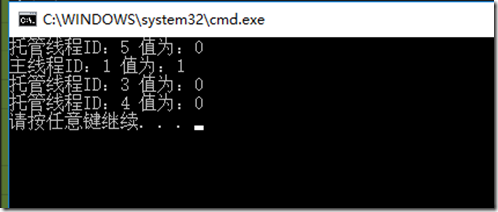一、TLS
线程本地存储(Thread Local Storage),字面意思就是专属某个线程的存储空间。变量大体上分为全局变量和局部变量,一个进程中的所有线程共享地址空间,这个地址空间被划分为几个固有的区域,比如堆栈区,全局变量区等,全局变量存储在全局变量区,虚拟地址固定;局部变量存储在堆栈区,虚拟地址不固定。每个线程都有自己的栈空间,局部变量就存储在栈空间里面,虽然这个局部变量是与线程相联系的,但是这个局部变量不能在不同的函数栈中互相直接访问,但TLS可以,概括来讲,TLS是属于线程的“局部变量”,作用域为线程作用域,而不像全局变量为全局作用域,局部变量为局部作用域,因为这个变量独属于这个线程,所以这个变量是线程安全的。
二、.NET中相关的类——ThreadLocal
代码更直观,请看下面的代码:
1 static void Main(string[] args) 2 { 3 ThreadLocal<int> threadLocal = new ThreadLocal<int>(); 4 //在主线程这个变量值为1 5 threadLocal.Value = 1; 6 new Thread(() => Console.WriteLine($"托管线程ID:{Thread.CurrentThread.ManagedThreadId} 值为:{threadLocal.Value++}")).Start(); 7 new Thread(() => Console.WriteLine($"托管线程ID:{Thread.CurrentThread.ManagedThreadId} 值为:{threadLocal.Value++}")).Start(); 8 new Thread(() => Console.WriteLine($"托管线程ID:{Thread.CurrentThread.ManagedThreadId} 值为:{threadLocal.Value++}")).Start(); 9 Console.WriteLine($"主线程ID:{Thread.CurrentThread.ManagedThreadId} 值为:{threadLocal.Value}"); 10 }
输出结果如下:
可以看见每个这个变量的值对于每个线程来说都是独立的,一个线程对这个变量的修改只会影响本线程的读取,每个线程都有一份拷贝。
有什么用呢?或者使用场景是什么呢?我觉得就是一句话——当每个线程都需要一个唯一的变量的时候。
比如早期版本的ASP.NET,每个线程处理一个Http请求,在处理这个Http请求的线程中,这个HttpContext在这个线程中是唯一的,所以在每个函数中都可以调用HttpContext.Current获得当前Http请求上下文对象,为了加深理解,请看下面的代码
1 public class ConsoleContext 2 3 { 4 5 private static ThreadLocal<ConsoleContext> _tlsCCT = new ThreadLocal<ConsoleContext>(); 6 7 private string _consoleName; 8 9 public string ConsoleName { get => _consoleName; } 10 11 public static ConsoleContext Current { get => _tlsCCT.Value; } 12 13 public ConsoleContext(string consoleName) 14 15 { 16 17 _consoleName = consoleName; 18 19 _tlsCCT.Value = this; 20 21 } 22 23 public static void ResetContext() => _tlsCCT.Value = null; 24 25 } 26 27 public static void Excute() 28 29 { 30 31 Thread.Sleep(1000 * new Random(DateTime.Now.Millisecond).Next(5,10)); 32 33 Console.WriteLine("进入PrintName()"); 34 35 PrintName(); 36 37 } 38 39 public static void PrintName() 40 41 { 42 43 var name = ConsoleContext.Current.ConsoleName; 44 45 Console.WriteLine($"当前托管线程ID:{Thread.CurrentThread.ManagedThreadId} name:{name}"); 46 47 } 48 49 static void Main(string[] args) 50 51 { 52 53 while (true) 54 55 { 56 57 var name = Console.ReadLine(); 58 59 ThreadPool.QueueUserWorkItem(state => 60 61 { 62 63 Console.WriteLine($"当前托管线程ID:{Thread.CurrentThread.ManagedThreadId} name:{name}"); 64 65 new ConsoleContext(name); 66 67 Excute(); 68 69 ConsoleContext.ResetContext(); 70 71 }); 72 73 } 74 75 }
简单来说,我模拟了一个Web服务器的行为,监听请求(在这里是监听键盘输入),若没有请求过来,服务器程序阻塞,若有请求过来(在这里是键盘输入),服务器响应请求,生成当前请求上下文,并生成一个TLS变量,然后执行Excute函数(相当HttpContext流入处理管道),最后清空TLS变量中的值,因为该线程是线程池中的线程,会被复用用于处理其他请求,不清空TLS会生成脏数据。
